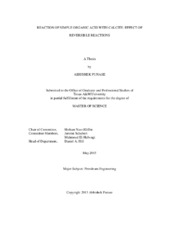| dc.description.abstract | Matrix acidizing is widely-used in the petroleum industry as a production enhancement technique. In order to design a successful acidizing job, it is important that all aspects of the reaction between the treating acid and the formation rock are understood. The reaction-rate studies involving organic acids seem to present conflicting results regarding the influence of reversible reactions. The primary objective of this paper is to comprehensively investigate the effects of the backward reactions on the kinetics of the acidizing process.
In order to understand how weak acids influence the reaction process, a comparative study of the different mathematical models existing in the literature was conducted and its results have been included in this work. Moreover, experimental data were also generated by carrying out experiments with acetic acid on calcite marble disks at different temperatures (80, 150, 200, and 250°F), acid concentrations (0.5, 1.0, 1.5, and 2.0 molar), and disk rotational speeds (100 - 1700 RPM) using a rotating disk apparatus.
These studies suggest that the rock porosity and backward reactions can significantly affect the rate of reaction and should not be neglected. For acidizing processes involving weak organic acids (such as acetic acid, formic acid, lactic acid, etc.), it was observed that the dissolution rates estimated by the different models gave distinct results and varied in two order of magnitudes from each other. This large variation can be attributed to the fact that the rate determination process by one method account for the concentration of all the interfacial ions generated during the reversible reactions, whereas the other approach considers only the presence hydrogen ions as a rate affecting parameter.
The inclusion of reversible reaction effects on the kinetics study can improve the accuracy up to 55-60%. Therefore, evaluation of all these aspects can lead us to develop a better field approach intended for the use of weak organic acids for well stimulation jobs. It also emphasizes that strong and weak acid systems have very different surface reaction mechanisms and, therefore, their kinetics cannot be estimated in the same manner. | en |


